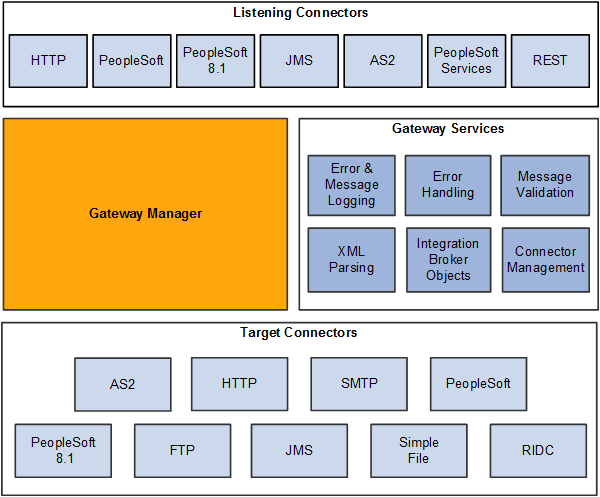Integration Gateway Architecture
This section discusses:
Architecture components.
Connectors.
Gateway manager.
Gateway services.
You use an integration gateway to receive and send messages among integration participant systems.
Listening connectors receive incoming messages and deliver the incoming requests to the gateway manager, which is a dispatcher for messages that flow through an integration gateway. The gateway manager determines which target connector to use to properly deliver the messages to their intended recipients. The target connector then delivers the messages to the intended recipients using the recipients’ preferred protocols.
Image: Integration Gateway Architecture
This image illustrates the components that comprise the architecture of the integration gateway.

Listening connectors and target connectors transport messages between integration participants and the integration gateway. These connectors support asynchronous and synchronous message handling. Many connectors are configurable at the integration gateway and system levels.
Listening Connectors
Listening connectors receive incoming data streams and perform services based on the content of the stream. They are invoked externally by other PeopleSoft systems and third-party systems.
Target Connectors
Target connectors initiate communication with other PeopleSoft systems or third-party systems. A target connector might not receive a response from the target system during each operation, but every transmission requires a low-level acknowledgment.
PeopleSoft Integration Broker Connector SDK
The integration gateway provides a fully extensible model for developing new connectors built to the interface specification of the PeopleSoft Integration Broker software development kit (SDK) by PeopleSoft customers, consultants, and application developers.
The gateway manager processes every message that flows through an integration gateway and maintains links to the other major integration gateway components, including target connectors, listening connectors, and each of the gateway services.
Listening connectors invoke the gateway manager when they receive a request. The gateway manager uses the messaging objects IBRequest and IBResponse to determine how to route each request.
The gateway manager uses a number of the gateway services during this stage to perform operations such as message validation. The gateway manager then invokes the appropriate target connector based on the content of the message object and waits for a reply from the target connector. When the reply is received, the gateway manager forwards the reply to the calling listening connector.
If an error occurs, the gateway manager uses the error handling service and works with the service to prepare an error reply for the listening connector.
This section describes the gateway services that the gateway manager uses.
XML Parsing
Most IBRequest objects and IBResponse objects that are processed in the system contain a content section that represents the actual business content sent.
Most of the time, these content sections contain XML data. Consequently, often connectors must parse and traverse XML. The standard Java XML objects are cumbersome for manipulating XML, so the integration gateway includes an XML parsing service consisting of objects that provide an intuitive interface for manipulating XML objects. This service is delivered as a set of three classes: XmlDocument, XmlNode and XmlNodeList.
See the product documentation for PeopleTools 8.55: PeopleCode API Reference .
Integration Broker Objects
Two objects comprise the messaging objects service in the integration gateway:
IBRequest
IBResponse
These objects represent the request and response that enter and exit PeopleSoft Integration Broker.
Connector Management
The connector management service is a composite of several services that manage connectors. The gateway processes each IBRequest to determine the appropriate connector to call in each situation. This is primarily a message routing function that has varying levels of complexity abstracted from the connectors. The connector management service also processes the IBResponse returned by each connector.
WS-Security
WS-Security is an extension to the concept of the SOAP envelope header that enables applications to construct secure SOAP message exchanges. It also provides a means for associating security tokens with messages.
Error and Service Operation Logging
Most components in the system use a standard error logging interface.
Each PeopleSoft-delivered connector uses the logging API in the same fashion, ensuring that an administrator can quickly drill down on problems or simply review the logs to see the IBRequest object, the IBResponse object, and even the raw data exchanged with integration participants.
See Understanding Error Handling, Logging, Tracing and Debugging.
Error Handling
The integration gateway provides a standard error handling interface that is exposed to each connector. This service provides error handling and error logging for most connectors delivered with PeopleSoft Integration Broker.
Message Validation
Messages that pass into PeopleSoft Integration Broker must contain certain elements to be processed. Because the integration gateway is the first component that processes messages sent to a PeopleSoft application, it performs basic validation—such as making sure that the message identifies its requestor and service operation name—to ensure that the integration engine and the target application can process them.